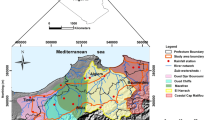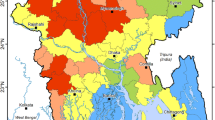Abstract
This paper presents a novel method of spatially representing the likelihood of occurrence of a contaminant in groundwater at the scale of a municipality or watershed. The specific contaminant of concern in the case study area is arsenic, which is variably present in groundwater at concentrations exceeding the 10 µg/l drinking water guideline. The method used to produce the likelihood of occurrence map incorporates confidence of geochemical interpretation based on availability of information and data on each aquifer. While demonstrated using arsenic as the contaminant of interest, the approach is readily adapted to other groundwater constituents. The final map is intended to be of use to water managers as it provides a spatial representation of aquifers of concern and identifies areas where further sampling or monitoring may be needed.







Similar content being viewed by others
References
Appelo CAJ (1994) Cation and proton exchange, pH variations, and carbonate reactions in a freshening aquifer. Water Resour Res 30:2793–2805
Appelo CAJ, Postma D (2006) Geochemistry, groundwater and pollution, 2nd edn. AA Balkema Publishers, Leiden
Back W (1961) Techniques for mapping hydrogeochemical facies. USGS Geological Survey Research, Short Papers in the Geologic and Hydrologic Sciences, No. 423. US Geological Survey, Denver, Colorado, pp D381–D382
Bowell RJ (1994) Sorption of arsenic by iron oxides and oxyhydroxides in soils. Appl Geochem 9:279–286
Brunt R, Vasak L, Griffioen J (2004a) Arsenic in groundwater: probability of occurrence of excessive concentration on global scale. International Groundwater Resources Assessment Centre (AGRAC) Report SP 2004-1
Brunt R, Vasak L, Griffioen J (2004b) Fluoride in groundwater: probability of occurrence of excessive concentrations on global scale. International Groundwater Resources Assessment Centre (AGRAC) Report SP 2004-2
Buschmann J, Berg M, Stengel C, Sampson ML (2007) Arsenic and manganese contamination of drinking water resources in Cambodia: coincidence of risk areas with low relief topography. Environ Sci Technol 41:2146–2152
Canadian Council of Ministers of the Environment (2001) Canadian Water Quality Index 1.0 Technical report and user‘s manual
Cavalcanti de Albuquerque R (2011) Hydrochemical evolution and arsenic mobilization in confined aquifers formed within glaciomarine sediments. MSc thesis, Department of Earth Sciences, Simon Fraser University
Chapelle FH, Knobel LL (1983) Aqueous geochemistry and the exchangeable cation composition of glauconite in the Aquia Aquifer, Maryland. Ground Water 21:343–352
Craw D, Falconer D, Youngson JH (2003) Environmental arsenopyrite stability and dissolution: theory, experiment, and field observations. Chem Geol 199:71–82
Cullen WR, Reimer KJ (1989) Arsenic speciation in the environment. Chem Rev 89:713–764
Dunn G, Norman E, Baker K, Allen DM, Cavalcanti de Albuquerque R (2012) Water security status indicators. Part 2, Section 4 in Water Security Guidance Document, Program on Water Governance, University of British Columbia and Earth Sciences, Simon Fraser University, 154 p. http://www.watergovernance.ca/1780/water-security-guidance-document/ (Accessed May 2012)
ESRI (2011) ArcGIS Desktop: Release 10. Environmental Systems Research Institute, Redlands
Golder Associates Ltd (2005) Comprehensive groundwater modelling assignment. Final report submitted to the Township of Langley, British Columbia
Halstead EC (1986) Ground water supply: Fraser Lowland, British Columbia. National Hydrology Research Institute Paper No. 26, IWD Scientific Series No. 146, National Hydrology Research Centre, Saskatoon, 80
Hopenhayn C (2006) Arsenic in drinking water: impact on human health. Elements 2:103–107
Jones BF, Vengosh A, Rosenthal E, Yechieli Y (1999) Geochemical investigations. In: Bear J, Cheng AH, Sorek S, Ouazar D, Herrera I (eds) Seawater intrusion in coastal aquifers: concepts, methods and practices. Kluwer Academic Publishers, Dordrecht, pp 51–71
Kreye R, Wei M (1994) A proposed aquifer classification system for groundwater management in British Columbia. British Columbia Ministry of Environment, Lands and Parks, Water Management Division, Victoria
Lambrakis N (2006) Multicomponent heterovalent chromatography in aquifers: modelling salinization and freshening phenomena in field conditions. J Hydrol 323:230–243
Lloyd JR, Oremland RS (2006) Microbial transformations of arsenic in the environment: from soda lakes to aquifers. Elements 2:85–90
Mendizabal I, Stuyfzand PJ (2009) Guidelines for interpreting hydrochemical patterns in data from public supply well fields and their value for natural background groundwater quality determination. J Hydrol 379:151–163
Mendizabal I, Stuyfzand P, Wiersma A (2011) Hydrochemical system analysis of public supply well fields to reveal water-quality patterns and define groundwater bodies, The Netherlands. Hydrogeol J 19:83–100
Nesbitt HW, Muir IJ, Prarr AR (1995) Oxidation of arsenopyrite by air and air-saturated, distilled water, and implications for mechanism of oxidation. Geochim Cosmochim Acta 59:1773–1786
Payne SM, Woessner WW (2010) An aquifer classification system and geographical information system-based analysis tool for watershed managers in the western USA. J Am Water Resour Assoc 46:1003–1023
Pierce ML, Moore CB (1982) Adsorption of arsenite and arsenate on amorphous iron hydroxide. Water Res 16:1247–1253
Smedley PL, Kinniburgh DG (2002) A review of the source, behaviour and distribution of arsenic in natural waters. Appl Geochem 17:517–568
Stüben D, Berner Z, Chandrasekharam D, Karmakar J (2003) Arsenic enrichment in groundwater of West Bengal, India: geochemical evidence for mobilization of As under reducing conditions. Appl Geochem 18:1417–1434
Stumm W (1984) Interpretation and measurement of redox intensity in natural waters. Aquat Sci Res Across Bound 46:291–296
Stuyfzand PJ (1999) Patterns in groundwater chemistry resulting from groundwater flow. Hydrogeol J 7:15–27
Township of Langley (2007) Water Quality Report. Township of Langley, British Columbia
Vasak S, Brunt R, Griffioen J (2006) Mapping of hazardous substances in groundwater on a global scale. In: Arsenic in Groundwater—a World Problem. Netherlands National Committee—International Association of Hydrogeologists (NNC-IAH), pp 82–92
Wilson JE, Brown S, Schreier H, Scocill D, Zubel M (2008) Arsenic in groundwater wells in quaternary deposits in the Lower Fraser Valley of British Columbia. Can Water Resour J 33:397–412
Yunmei Y, Yongxuan Z, Williams-Jones AE, Zhenmin G, Dexian L (2004) A kinetic study of the oxidation of arsenopyrite in acidic solutions: implications for the environment. Appl Geochem 19:435–444
Acknowledgments
This article is the product of the second phase of a four-year (2008–2012) research project “Developing a Canadian Water Security Framework as a Tool for Improved Governance for Watersheds” that will create a Water Security Framework (WSF), which includes decision-support tools for water managers. This research project, led by Dr. Karen Bakker (University of British Columbia) and Dr. Diana Allen (Simon Fraser University), is funded by Grants from the Canadian Water Network (CWN) and the Walter and Duncan Gordon Foundation. This component of the project targeted the spatial representation of water quality data. The authors would particularly like to thank Marc Zubel, Dean Scovill, Mark Sloat, Township of Langley, and the Fraser Health Authority for access to groundwater chemistry data.
Author information
Authors and Affiliations
Corresponding author
Rights and permissions
About this article
Cite this article
de Albuquerque, R.C., Allen, D.M. & Kirste, D. A methodology for spatially representing the likelihood of occurrence of natural contaminants in groundwater. Environ Earth Sci 68, 1863–1875 (2013). https://doi.org/10.1007/s12665-012-1874-x
Received:
Accepted:
Published:
Issue Date:
DOI: https://doi.org/10.1007/s12665-012-1874-x




